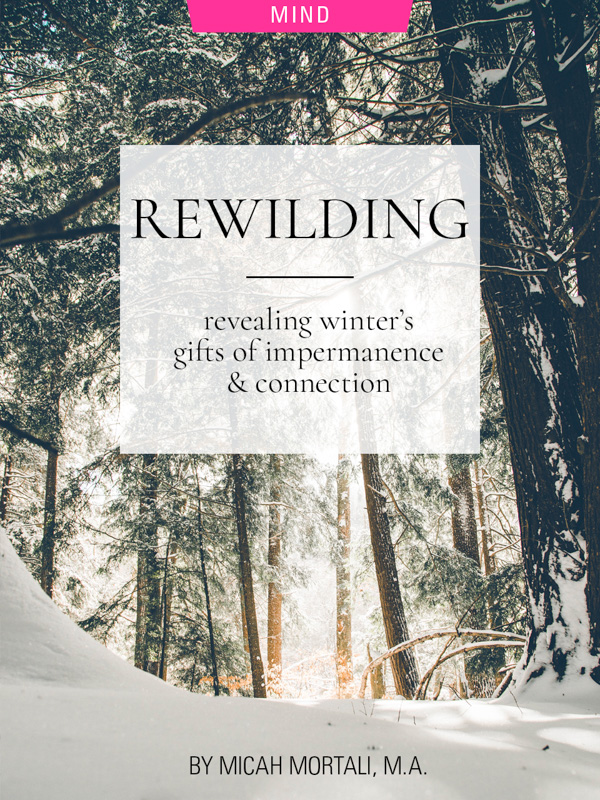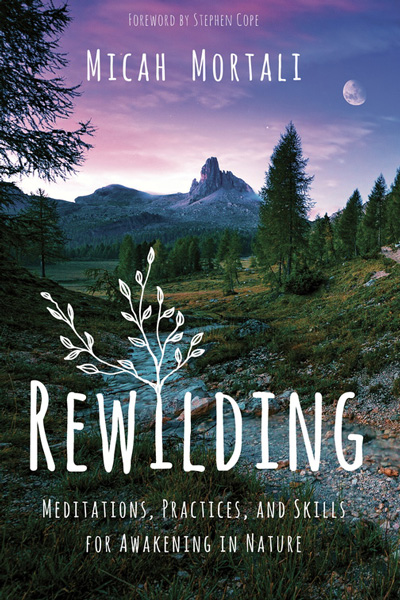
How ‘rewilding’ not only calms the nervous system, it reestablishes our bond with the living earth and our true selves
_
I have a favorite patch of forest near Lake Mahkeenac in Stockbridge, Massachusetts, where I like to guide my groups. The trail winds through a forest of mixed hardwoods and evergreens, passing several massive eastern white pine trees.
I once walked in these woods on a bitter cold November Sunday with my son, Stryder, when he was four, and my good friend and mentor Moose, the groundskeeper and land steward at Kripalu. On that particular morning, Stryder sat down at the base of a massive tree, closed his eyes, and interlaced his little fingers in a prayer mudra. He sat there, and from what I could tell, prayed or meditated for a full five minutes. I observed him in wonder as my heart filled up to the brim and spilled over with love and gratitude for such a perfect moment.
When Moose let me know that the big tree where my son sat in prayer had recently broken off, about ten feet up, and fallen to the ground, I couldn’t help but feel sadness at the demise of the great tree, also a reminder of my son’s childhood passing by so quickly. I felt my heart opening big, vulnerable to the sweetness of life’s temporary treasures.
Life’s impermanence is on display so fully in the winter woods. Our species evolved, after all, in deep connection with trees. Impermanence is all around us, and though we may try to build walls of security, nature eventually washes them away or blows them down.
It is in surrendering and opening to this essential impermanence of nature that we can begin to live in harmony with our world, taking each moment as a gift and giving thanks for the moments we have, as precious and miraculous as they are.
This time of year can be stressful and hectic, and yet, right in the midst of this busy season comes the winter solstice — marking the shortest day and longest night of the year. It’s an ideal time to gift yourself with an embodied experience of the peace and stillness that can be found in nature during this season — even if you can’t get to the forest.
Rewilding is a return to our essential nature. It is an attempt to reclaim something of what we were before we used words like ‘civilized’ to define ourselves.
~ Micah Mortali
Here are a few ways to do that.
Do a candle or Christmas tree tratak meditation
Tratak means ‘to look or gaze’, and tratak meditation can be practiced on any object. A candle is one of the most traditional objects for tratak — or you can use the lights of your Christmas tree. Wrap yourself up in a blanket or cloak, turn out all the other lights in the room, and settle onto your cushion, letting your gaze rest on the tree or candle flame. When we gaze at flames or soft lights, our beta brainwave/monkey-mind activity shifts into alpha and theta, allowing the mind to become more relaxed, open, and receptive.
Connect with the evergreens
Spending time with the evergreen trees connects us with nature and reminds us of the life force within all beings that flourishes quietly even in the coldest months. Take a walk through the forest and appreciate the trees with all five senses. You could even make a white pine needle tea to sip on the solstice: Gather some white pine needles, drop in a boiling pot of water, and let steep for 1–3 minutes. The tea will smell and taste of the subtle scent and flavor of pine. If you’d like, add a little maple syrup. Allow yourself the time to smell, sip, and savor the experience of this communion with a tree.
Bring your attention to the transformation of water
There’s a profound, magical beauty to the way in which water transforms into ice and snow — an opportunity for us to tune in to the everyday alchemy of nature. Take a walk on or around the solstice with water, in all its forms, as the focus of your awareness.
Practice yoga nidra or restorative yoga
Align with this restful, quiet time of year by doing a slow, inward-focused practice. End your day with a peaceful yoga nidra or a restorative pose, such as supported Child pose: Spread the knees wide, place a bolster or two pillows under your chest and head, and turn your face to one side. Relax into the support, taking long, deep breaths.
Find a ‘sit spot’
The solstice is a great time to start a sit-spot practice; a foundational practice of the Kripalu School of Mindful Outdoor Leadership. Find a place in your yard or a nearby park that you can return to on a regular basis, observing the land and the behavior of the flora and fauna as time passes and the days gradually grow longer. Even five or 10 minutes spent in your spot daily, or every few days, will result in a growing bond with the landscape and a deeper awareness of the subtle seasonal changes.
Burn a yule log outside
According to pagan mythology, the battle between the Oak King and the Holly King comes to its peak on the Winter Solstice, when the Holly King, king of the waning year, is overcome by the Oak King, king of the waxing year, who then reigns supreme until midsummer. The two brothers are in an eternal struggle for the love of the Goddess (Earth), who reigns all year long. The burning of the Yule log marks this cycle of death and rebirth, and reminds us that the spring will come again, and the cycle will continue. May your solstice and New Year be a time of healing, rest, and reflection.
You may also enjoy reading Forest Bathing: How Immersing in Nature Can Help You Reconnect, by Tess Dinapoli
